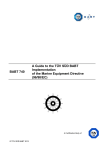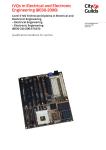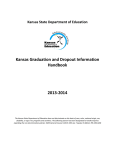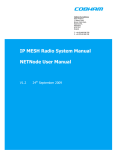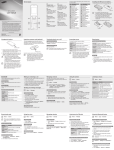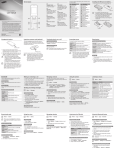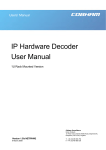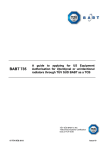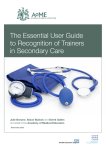Download BABT 793 A Guide to the TÜV SÜD BABT Implementation of the
Transcript
BABT 793 A Guide to the TÜV SÜD BABT Implementation of the Construction Products Directive (89/106/EEC) TÜV SÜD BABT is a certification body of © BABT 2012 Issue 1 Foreword TÜV SÜD BABT is an accredited Certification Body, and appointed as a Notified Body under the Construction Products Directive ( 89/106/EEC) This guide overviews the TÜV SÜD BABT implementation of the Constructions Products Directive. The implementation of the Production Control requirements is explained in detail in BABT 795. This guide is designed so that the essential information can be read quickly by reading the main text only. Where you require more information, refer to the appropriate shaded text. The scheme enables you to mark your products as approved and cite the TÜV SÜD BABT Notified Body number. The formal requirements of the scheme are set out in the Certification Regulations. All TÜV SÜD BABT publications are available from: http://www.babt.com or TÜV SÜD BABT Octagon House Concorde Way Segensworth North Fareham Hampshire PO15 5RL United Kingdom Tel: +44 (0) 1489 558100 Fax: +44 (0) 1489 558101 e-mail : [email protected] Guide to the BABT Implementation of the Construction Products Directive BABT 793 Issue 1 Page i of ii Contents 1. Introduction ................................................................................................................... 1 1.1 Scope ........................................................................................................................................................... 1 1.2 Definitions and Terms................................................................................................................................ 1 1.3 Overview ..................................................................................................................................................... 2 2. Making an application for a Product Conformity Certificate .................................... 3 2.1 How to apply ............................................................................................................................................... 3 2.2 Who can apply ............................................................................................................................................ 3 2.3 2.3.1 Type of Application .................................................................................................................................... 3 Brandname applications ............................................................................................................................... 3 3. Information required on the application form ............................................................ 5 3.1 Section A: Applicant Details ..................................................................................................................... 5 3.2 3.2.1 3.2.2 Section B : Your Certification requirements. .......................................................................................... 5 Type of Application ....................................................................................................................................... 5 Applicable Product Standard ........................................................................................................................ 6 3.3 3.3.1 3.3.2 Section C: Product Details ........................................................................................................................ 6 Products Submitted ...................................................................................................................................... 6 Related Products .......................................................................................................................................... 6 3.4 3.4.1 3.4.2 Section D: Production Facility ................................................................................................................. 6 Registered Production Facility ...................................................................................................................... 6 Production Test Plan(s) ................................................................................................................................ 7 3.5 Section E Commercial Information........................................................................................................... 7 3.6 Section F Agreement.................................................................................................................................. 7 3.7 Annex A ....................................................................................................................................................... 7 4. Progressing the Application ........................................................................................ 7 5. Information to accompany an application .................................................................. 8 5.1 General ........................................................................................................................................................ 8 5.2 Technical Documentation File Index ........................................................................................................ 8 5.3 Purpose of Equipment and identification of equipment ........................................................................ 8 5.4 Block Diagram ............................................................................................................................................ 9 5.5 Circuit Diagrams and PCB layout Diagrams ............................................................................................ 9 5.6 Critical Components List ........................................................................................................................... 9 5.7 Software and firmware Versions............................................................................................................... 9 5.8 Photographs or Illustrations ..................................................................................................................... 9 5.9 Compliance Strategy(ies) .......................................................................................................................... 9 5.10 5.10.1 5.10.2 Declarations .............................................................................................................................................. 10 Modular Design .......................................................................................................................................... 10 Product Families ......................................................................................................................................... 10 5.11 User Instructions ...................................................................................................................................... 10 5.12 D of C ......................................................................................................................................................... 10 5.13 Draft CE Marking. ..................................................................................................................................... 10 6. Testing and test reports ............................................................................................. 10 6.1 Introduction .............................................................................................................................................. 10 Guide to the BABT Implementation of the Construction Products Directive BABT 793 Issue 1 Page ii of ii 6.2 Requirements for Test Facilities ............................................................................................................. 10 6.3 On site testing (Testing outside a Test Organisation site) .................................................................. 11 6.4 Supply of Information .............................................................................................................................. 11 6.5 Test Plans ................................................................................................................................................. 11 6.6 Test Reports ............................................................................................................................................. 11 6.7 6.7.1 Aspects of Testing ................................................................................................................................... 11 Choice of Samples ..................................................................................................................................... 11 7. Production Test Plans ................................................................................................ 12 7.1 General ...................................................................................................................................................... 12 7.2 Contents of a Test Plan ........................................................................................................................... 12 7.3 VMS Test Module Plans ........................................................................................................................... 12 8. Certificates and Records ........................................................................................... 12 8.1 Certificates ................................................................................................................................................ 12 8.2 Records ..................................................................................................................................................... 13 9. Regulatory Marking. ................................................................................................... 13 9.1 Marking on the Product ........................................................................................................................... 13 9.2 Marking on accompanying commercial documentation ...................................................................... 13 10. Annual Continuation of the Certificate ..................................................................... 14 11. Keeping your Product Conformity up to Date .......................................................... 14 11.1 General ...................................................................................................................................................... 14 11.2 11.2.1 11.2.2 11.2.3 11.2.4 11.2.5 11.2.6 11.2.7 11.2.8 Authorisation of Changes to Certified Equipment ................................................................................ 14 General ....................................................................................................................................................... 14 Certification Liaison Engineer(CLE) ........................................................................................................... 14 Changes to product supporting items unrelated to the certified product .................................................... 14 Changes to aspects of the product covered by self-declaration or other compliance schemes ................ 14 Changes to the certified product which do not affect conformity to the certification requirements ............ 15 Changes to the certified product which potentially affect conformity to the certification requirements covered by the certificate and thus need testing ........................................................................................ 15 Changes to the Production Facility ............................................................................................................. 15 Changes to Standards ................................................................................................................................ 15 11.3 Any Other Changes .................................................................................................................................. 15 12. Monitoring by TÜV SÜD BABT .................................................................................. 16 12.1.1 Causes for monitoring ................................................................................................................................ 16 Guide to the BABT Implementation of the Construction Products Directive 1. Introduction 1.1 Scope BABT 793 Issue 1 Page 1 of 16 This guide overviews the TÜV SÜD BABT implementation of the Construction Products Directive (89/106/EEC) It also details the full requirements for the Product Certification process . are detailed in document BABT 795 The requirements for Production control TÜV SÜD BABT are appointed as a Notified Body following System 1 for the following Standards . EN 54-4 Fire Detection and fire alarm systems - Part 4 Power supply equipment EN 54-16 Fire Detection and fire alarm systems - Part 16 Voice alarm control and indicating equipment EN12966 Road vertical signs Variable message traffic signs – Part 1 Product Standards 1.2 Definitions and Terms Manufacturer A manufacturer is the person who is responsible for designing and manufacturing a product with a view to placing it on the Community Market on his own behalf. The Manufacturer has an obligation to ensure that a product intended to be placed on the community market is designed and manufactured, and its conformity assessed to the essential requirements. The Manufacturer must always retain the overall control and have the necessary competence to take responsibility for the product. Authorised Representative The Manufacturer may appoint any natural or legal person to act on his behalf as an Authorised Representative. The Authorised Representative must be established inside the Community. An Authorised Representative may be addressed by the authorities of the Member states instead of the manufacturer with regard to the latter’s obligations under this directive. The Manufacturer remains generally responsible for actions carried out by an Authorised Representative on his behalf. Importer An Importer (a person responsible for placing the product on the market) is any natural or legal person established in the Community who places a product from a third country on the Community market. The importer must ensure that he is able to provide the market surveillance authorities with the necessary information regarding the product where the manufacturer is not established in the community and has no Authorised Representative in the Community. Agent An Agent is a natural or legal person, established either within the Community or elsewhere in the world, appointed by the Manufacturer to act on his behalf with respect to the application. Where the Agent is not the nominated Authorised Representative the application must include a letter from either the Manufacturer or the Authorised Representative authorising TÜV SÜD BABT to communicate with the Agent for matters related to the application. Applicant The Applicant must be either the Manufacturer or the Authorised Representative. An application may not be made in the name of an Agent who is not also the Authorised Representative. Brand Name Application An Application for a Certificate naming the Brand name Company as the Manufacturer This application is based on making use of an existing Certificate which names the Original Product Manufacturer. Brand name products are normally the same as the original product with the exception of cosmetic difference (e.g. labels, enclosure colours) and often follow the same production line processes as the original products. Brand name certificates are sometimes also referred to as co-licence certificates Guide to the BABT Implementation of the Construction Products Directive 1.3 BABT 793 Issue 1 Page 2 of 16 Overview There are 2 parts to obtain a Product Conformity Certificate : Testing of a product followed by Type examination Assessment of the Production Facility for TÜV SÜD BABT registration The requirements for testing and Type examination are detailed in this document The requirement for the Registration of a Production Control Facility(Production Quality Approval) are detailed in BABT 795. BABT CPD Process Client makes application for a CPD Product using BABT 794 BABT Accept and process Application Allocated Product Certifier reviews and agrees the manufacturing Test Plan(s) Allocated Product Certifiers review the Technical file until satisfactory No Client makes an application for registration as a CPD Factory Production Control Facility using BABT 796 Is Facility Registered for CPD by BABT BABT operate a “4 eyes review process” Yes Client makes an application to add a product to an existing CPD Factory Production Control Registration using BABT 797 BABT Accept and process Application BABT Accept and process Application Allocated QMS Certifier reviews Application and determines whether an audit is required Yes Audit Scheduled and performed, Major findings cleared, Outcome reviewed by QMS Certifier Audit Required No Production Control Registration Prepared and issued Production Control Registration added to Product Certificate of Conformity Product Conformity Certificate Issued Client advised of Approval Guide to the BABT Implementation of the Construction Products Directive BABT 793 Issue 1 Page 3 of 16 Note: Since the Process to register a Production Facility normally takes in excess of 3 months TÜV SÜD BABT advise making the application for registration as early as possible (e.g. While testing is planned/being undertaken). The Manufacturing Test Plans for each product must be agreed prior to the on-site audit. 2. Making an application for a Product Conformity Certificate 2.1 How to apply The application is an order for TÜV SÜD BABT ’s certification services and should be made direct to TÜV SÜD BABT ( Refer to the foreword for details) Applications will be accepted by post, or email, to [email protected]. The application must be made using form BABT 794 and must be accompanied by the required information to support the assessment. On receipt of your application, TÜV SÜD BABT will generate and send you a confirmation of the application. Where a TÜV SÜD company (e.g. TUV SUD Product Service Ltd) have taken the order for testing and certification you should discuss with your contact the best way to deliver the application to TÜV SÜD BABT . Regular customers of TÜV SÜD BABT may request an FTP upload address as an alternative to e-mail or post but must advise TÜV SÜD BABT Customer service when an application is fully uploaded. 2.2 Who can apply Applications can be made by Manufacturers or Authorised Representatives of equipment under the Construction Products Directive. Normally the person making the application should be a duly authorised signatory of the applicant . Applications may also be made in the name of the Manufacturer by an Authorised Representative or suitably authorised Agent. Please note the Product Conformity Certificate will be issued listing the applicant company as holder.. 2.3 Type of Application An Application may be made for An Original Certificate; or A modification to an existing certificate; or a Certificate for a Brand name(co-licence) of the product. The main information in this guide applies to applications for original certificates. 2.3.1 Brandname applications 2.3.1.1 Introduction Brand name products are normally the same as the original product with the exception of cosmetic difference (e.g. Labels, enclosure colours) and often follow the same production line processes as the original products. Brandname applications may only be made where a substantial amount of the testing applied to the original product still applies to the Brand name. ( e.g. A Brand name product may have a different housing which would require additional EMC testing, but should not vary in functionality or key characteristics) . Where there are any technical differences TÜV SÜD BABT reserve the right to require a brand name application be re-classified as an original application with original supporting data. Guide to the BABT Implementation of the Construction Products Directive BABT 793 Issue 1 Page 4 of 16 2.3.1.2 Options for Brandname Products Brandname Product Does Product Label list the OEM Manufacturer as the Manufacturer Yes Product may be listed as a variant on the Product Conformity Certificate of the original product No Brandname manufacturer Issue a new Product Conformity Certificate in Brandname manufacturers name Yes Brandname Manufacturer may be listed on the OEM Production Control Registration Brandname Product may be listed on the OEM Production Control Registration Amended OEM Production Control Registration Is the Application from the the Brandname manufacturer or from their Authorised Representative Authorised Rep Issue a new Product Conformity Certificate in manufacturers name If added to OEM Product Conformity Certificate Brandname Must be added to the Production Control Registration held by the OEM manufacturer Is the OEM Manufacturer listed as the Authorised Rep on the Product Conformity Certificate Amended Both Certificates No A Brandname Production Control Registration will be required New Brandname Production Control Registration 2.3.1.3 Specific Information required with a Brandname application A Brandname application must be accompanied by the following: A statement of the differences between the original product and the Brandname product Where some differences are not cosmetic o A justification for using test data from the original product o Additional relevant testing for the technical differences Guide to the BABT Implementation of the Construction Products Directive BABT 793 Issue 1 Page 5 of 16 Where the Original product was not tested to the versions of the relevant standards current at the time of application for the Brandname certificate then either (or a selection of both) : o A justification showing the previous test results meet the requirements of the current issue of the standard; or o Testing to the updated standard (entirely or in part) Where there are multiple Brand names, test results from other Brand names to the latest standard may be used provided there is evidence that permission from that holder has been given ( It will not in this instance be presumed even if the original holder is an agent for both) Where you have appointed an Agent a letter from the Manufacturer appointing them The original Manufacturer may be appointed to act as the agent of the Brand name manufacturer. This may be beneficial where original and Brand name applications are made in parallel as the same person is authorised to make a response to common concerns in several applications. Where the Original Manufacturer is not the Agent of the Brandname holder then a letter from the original Certificate holder authorising the use of their test and technical date in support of the Brandname application. ( Agents who are the Original Manufacturer are assumed to authorise themselves). Either o A copy of the Brandname User manual; or o A statement that the only changes (if any) to the Original Holder User manual will be changes related to the Product name and manufacturer. Any of the other items required for original application where they differ significantly with that of the original product. An Application for a Technical modification to a Brandname which is not also applied to the Original product may result in the link to the Original product being broken such that future test results cannot be read across from the original product. 3. Information required on the application form 3.1 Section A: Applicant Details Section A.1 identifies the person within the organisation with whom TÜV SÜD BABT will communicate. The Company name and address are used as the address for the certificate. Where you are an Authorised Representative applying under your own company name it is MANDATORY that you provide full contact details of the Manufacturer including a contact name within the Manufacturer’s company. This information must be part of the application. Where you are a Manufacturer established outside the Community it is recommended that you appoint an Authorised Representative within the Community. Where an Authorised Representative has been appointed please provide full contact details of the Authorised Representative on headed paper from the Manufacturer. You may identify a consultant/agent to act on your behalf who is not formally appointed as an Authorised Representative . TÜV SÜD BABT require that you include a formal letter appointing the Agent (on headed paper and signed by an responsible person within the applicant company). Note: TÜV SÜD BABT will require this for every instance you send in an application and do not assume that an authorised agent for one application is authorised for another. Where you hold a Power of Attorney proof of this may be provided in place of a formal letter on company headed paper. 3.2 Section B : Your Certification requirements. 3.2.1 Type of Application You must indicate the type of Application. For modifications to existing Certificates or for applications for a Brandname/co-licence of an existing certificate you must provide the full TÜV SÜD BABT Certificate number of the current product Guide to the BABT Implementation of the Construction Products Directive BABT 793 Issue 1 Page 6 of 16 Where you are applying for a Brandname/co-licence Certificate in parallel with an application for an original product please list the Product name and brief details of the Applicant company of the original product instead of a certificate number 3.2.2 Applicable Product Standard Please indicate which standard is applicable for this application. National Versions of standards (e.g. BS EN 12966:2005) Where you have used a national published version of the listed standard please mark the applicable “EN” box and note the actual standard used under “Other” Later Versions of Standards If you wish to use a later version of a standard than is listed (or for modification that was originally used), please indicate this in the “Other” line. Other Standards Please do not list another standard number under “Other” without first agreeing this with TÜV SÜD BABT , as the standard may be outside the scope of the TÜV SÜD BABT appointment. 3.3 Section C: Product Details 3.3.1 Products Submitted This information is normally used to identify the product on the certificate. TÜV SÜD BABT will check this information with other identifying information within the application; any unexplained differences will cause delays in certification. Listing more than one product The Applicant, and Manufacturer must be the same for all listed products, which must be clearly indicated in the related User Manuals, and Declaration of Conformity. For Products tested in their entirety you may normally only list products with cosmetic (colour) or minor differences (language settings, or IT interface variations) on the same certificate. You may only list a Brand named product on the same certificate where the above criteria are met. Modular Designs Some products (e.g. Vertical Traffic Signs) are too large with a number of variations built on a fixed set of modules. Where the standard (e.g. EN12966) permits testing of such modules to demonstrate compliance any derived Product based upon the test module elements may be listed on the same certificate provided that clear traceability back to the modular design can be demonstrated. Note: The Testing must be conducted on release ready versions of the component parts/items and must not be conducted using prototype versions. Refer later for additional requirements for products derived from Modular Testing. 3.3.2 Related Products If your product is derived from one for which you currently hold a TÜV SÜD BABT Certificate and you wish to make use of any of the previous data, please indicate this and provide the TÜV SÜD BABT Certificate number related to that product While this could reduce the assessment time we will need a clear justification within the Technical File for the use of the earlier results. Likewise for Brandname/Co-licensed products, or applications covering more than one model, we require details of the differences between the models. Note: Where an application covers more than one model, TÜV SÜD BABT may charge an additional portion of our fee for assessing the additional model(s). 3.4 Section D: Production Facility 3.4.1 Registered Production Facility You must identify the production facility where the product will be manufactured. Where TÜV SÜD BABT have already issued a Registration of the Production Facility for the e to you for another product, please identify the registration number. Where you already hold a Construction Products PQA Certificate for the same type of product (based on using the same Standard for testing) it may be possible to add this product without requiring an Audit visit). Adding new product types will require a detailed review and could result in similar treatment. Guide to the BABT Implementation of the Construction Products Directive BABT 793 Issue 1 Page 7 of 16 Also if the Facility already is certified by TÜV SÜD BABT or another TUV Sud company to another QMS Standard (ISO9001, TÜV SÜD BABT PQC, etc) please list the Certificate number { and include a copy of the Certificate if it is from a TUV SUD company}. For facilities with such Certification it will still be necessary for you to apply for a Registration as a CPD Production Facility but the audit duration may be reduced, or combined audits planned. Where you have already applied for a one of the above but not received a certificate please indicate the Facility details and the Certificate type for which you have applied. Where you have no QMS Certification from TÜV SÜD BABT or TUV SUD for the facility you must complete an application to TÜV SÜD BABT for a Construction Products PQA Certificate. 3.4.2 Production Test Plan(s) TÜV SÜD BABT need to agree to the Manufacturing test plan for your product. Where TÜV SÜD BABT have already agreed to a test plan for the same type of product (or for the original product in the case of Brandname/Co-license applications) please indicate the reference number and date of the agreement with TÜV SÜD BABT . Where you list such an agreement you must include with the application a justification why this plan is suitable for the product in this application. Where you submit a new or amended test plan for agreement, in this application you must identify the Document number and issue status of the document in the application . Details of the content of Test Plans are described later in this document. 3.5 Section E Commercial Information Please complete this information. Clients applying directly to TÜV SÜD BABT (i.e. not through any other TUV Group office) who do not currently have approved credit facilities with either TÜV SÜD BABT or TUV Product Service UK must include a completed Credit Details Form with the application. Alternatively payment in advance is accepted. The appropriate forms may be downloaded from www.babt.com. 3.6 Section F Agreement This forms the contract with the Certification body. It must be completed and signed on or on behalf of the applicant . Normally it is signed by the listed main contact. 3.7 Annex A This section is intended as a brief checklist of possible contents of a Technical File sent with the application. It is not mandatory that this annex be completed or included with the application form. Details of the content of a technical file are described later in this document. 4. Progressing the Application When TÜV SÜD BABT has received your application and evaluated the initial information, we will: ask you to pay an application fee. The fee relates to the assessment of the application. Where you have identified a specific contact to whom to send the invoice it will be sent to them; otherwise it will be sent to the main contact. inform you of the TÜV SÜD BABT reference number assigned to your application. This number should be quoted in all further correspondence. review your application for completeness and consistency. Where information is missing from an application or the reviewing Engineer raises a query further work on that application will be suspended at an appropriate time and will only be resumed after the response. .Where TÜV SÜD BABT is satisfied we will with the Technical File, and supporting Production Control we will formally issue the Product Conformity Certificate. TÜV SÜD BABT will advise you when this occurs. If there is a significant shortfall which either cannot be remedied, or where the remedy is not submitted in a timely fashion TÜV SÜD BABT may dismiss the application. Note: If additional testing is required TÜV SÜD BABT will expect to be advised when this is due for completion. Each certificate will detail the applicant, product identity(ies), and the standards complied with; the certificate annex will detail technical information, the supporting Production Control Facility and the identities of the test reports. Each Certificate has a validity of 3 years from the time of issue. Guide to the BABT Implementation of the Construction Products Directive 5. Information to accompany an application 5.1 General BABT 793 Issue 1 Page 8 of 16 You should submit a Technical Documentation File to accompany the application. This file shall contain all the necessary information to evaluate compliance to the requirements and to record the build status of the product in sufficient detail to ensure later verification of product supplied against that certificate. The application supporting documentation should be submitted electronically as Adobe PDF, MS-Word, or jpg files (as applicable) in the required directory/folder structure Where the Standard defines a set of documentation to be provided for an application this must be complied with. Technical Documentation required for EN12966 Annex A of EN12966-2:2005 specifies the following sets of technical documentation as required. This should be taken into consideration for any application related to this standard Housing Material identification Suppliers Physical properties Dimensions Engineering drawings Optical test area details Electrical Equipment Component Details Suppliers Physical and electrical properties Engineering drawings Mounting Devices Material specifications Suppliers Physical properties Dimensions Engineering drawings Retro-reflective and non Retro Materials designation full technical details reflective components Trademarks Supplier Identification code/grade Classification Surface design Surface finishers full technical and component details Substrate full technical and component details However additional documentation may be provided ( as specified in this document). The following set of documents should be considered as appropriate to the application Documentation identification and Issue status All documents submitted electronically should be clearly named to indicate their purpose and contents. Documents submitted in paper format should be identified by document number and issue status (e.g. Issue number or date); For multi-page documents each page should hold such information and a page number indication. 5.2 Technical Documentation File Index Where there are multiple similar files or the purpose of individual files is not immediately evident it is recommended that you provide an index to the information to assist with the review process. 5.3 Purpose of Equipment and identification of equipment For multipurpose equipment, or systems where the functions are split between specific apparatus it is helpful if you include an expanded description of each item (Note: Extracts of sections of the supplied User Manual are not required.) Where you are seeking a certificate including more than one model we need clear information identifying each model and the differences between models. Guide to the BABT Implementation of the Construction Products Directive 5.4 BABT 793 Issue 1 Page 9 of 16 Block Diagram You should include a block diagram showing the following dependent upon the complexity of the apparatus. points of connection to other apparatus, or power sources indicators of key functionality connections to earth (protective or functional) For complex equipment with switching capabilities, include a cross connection matrix showing the possible connections through the equipment between the various ports and/or terminating stations, if relevant to the assessment The provision of a block/circuit diagram is essential to help ensure that all parties quickly reach a common understanding of the relevant tests and certifications required The block/circuit diagram should be accompanied by a brief technical description explaining how the equipment interacts with the communications networks concerned. 5.5 Circuit Diagrams and PCB layout Diagrams Detailed circuit diagrams and PCB layout diagrams are required for all circuits which may have an effect on conformity. Circuit Diagrams and PCB layout Diagrams must show all network or radio interface circuits, active speech processing devices, hybrids and transducers, line signalling components, power supplies, ports and all network-affecting circuit elements including any components providing user isolation. Circuit elements need only be shown in sufficient detail to explain the above. Circuit diagrams should match up with the actual samples submitted for certification. 5.6 Critical Components List A list of all Critical components shall be provided for the product. This list shall also contain details of the required order criteria for Purchasing such components, and the required receiving inspection checks to be performed by the Production Facility. Full Bills-of-materials may also be provided to assist in any later product verification. Parts lists for those areas of circuit detail identified in the circuit diagrams, data sheets for any critical component, and purchase specifications for any sub-assemblies. For EN12966 refer also to the above referenced table and supply the specified component/materials information 5.7 Software and firmware Versions The version of any software and firmware supplied with the apparatus which may affect compliance with the certification requirements must be declared. Software : Where the relevant software is installed separately from the hardware (e.g. device drivers in PCs) then installation conditions must be provided either as a part of the software installation package or in the user guide. Where special software is provided to enable testing, then the version of such software must be recorded with a clear statement about the relationship of this software to the production sample. 5.8 Photographs or Illustrations Photographs or illustrations showing the external features of the complete equipment are required where the user instructions/supplied Installation instructions do not include this information. 5.9 Compliance Strategy(ies) You should include details of the compliance strategy. This should include details of the Standards related to this product; any limitations in applicability of standards or tests that have been used Products based upon Modular Testing Where a Modular design has been tested the Compliance strategy shall provide details how the compliance of each Listed product design is achieved, and how this relates back to the tested Module. In particular this must address how compliance to aspects which vary between designs are met. Note: For some Characteristics this may involve additional test data related to the particular product Guide to the BABT Implementation of the Construction Products Directive 5.10 BABT 793 Issue 1 Page 10 of 16 Declarations 5.10.1 Modular Design Where the testing has been conducted using a test module then the application shall include justifications on why the results obtained on the Test Module are valid for each different type of production product. Additionally for each different product to be listed on a Certificate data or calculations on how the structural integrity and strength is achieved for each product must be included with the declaration. 5.10.2 Product Families Where one member of a product family has been tested the application shall include a justification why the results obtained on that product are valid for the other family members; Note : Where this justification cannot be made, or is insufficient additional testing of appropriate particular characteristics may be required to be performed on the other family members. Note: For Families of Product based on the Test Module this may be combined with the above. 5.11 User Instructions You should supply (in English) a draft or published set of User Instructions, and Installation Instructions where relevant. For complex equipment you need only include the sections of the user instructions relating to the compliance of the equipment with the standards. User Instructions should contain all the information for installation, use and maintenance required for conformance to the relevant standards, and should not give details of adjustments which can take the equipment outside compliance - unless it is made clear how to adjust the equipment to maintain compliance and that any non-compliant setting would invalidate the certification. The presence of user instructions at the earliest stages of assessment, even if in draft form, will give you the best possible chance of an accurate test schedule being written rapidly and a smooth assessment. If the User guide does not provide photographs or illustrations showing the external features of the complete equipment, this shall be provided separately. 5.12 D of C You should include a draft (or actual) Declaration of Conformity to Type within the Technical Documentation File. As a Minimum this should follow the requirements specified in the product standard. However where more than one Directive applies to the product it should meet the requirements of all those directives. Checks on D of C TÜV SÜD BABT will review your draft D of C and advise you of any observed concerns. While at the time of issue of the C of C TÜV SÜD BABT will not check these are met, this will be checked at the next Production Control Audit. 5.13 Draft CE Marking. You must provide a copy of your intended marking either as a copy of a label or a copy of the draft artwork for that label. TÜV SÜD BABT will review the marking for compliance with the labelling requirements from the appropriate standard and for consistency with the reported parameters from testing. TÜV SÜD BABT will not necessarily comment upon any statements required related to other Directives or the use of the Notified Body number of any other body. 6. Testing and test reports 6.1 Introduction The Technical Documentation File must include a test report showing compliance with the appropriate standard. The test report must come from an acceptable source of test reports. 6.2 Requirements for Test Facilities TÜV SÜD BABT normally require that the test reports are issued by a test laboratory accredited by UKAS or another national accreditation body where the scope of accreditation includes the required standards. Where there is no laboratory with the required standard within its scope, or where there is a clear justification for making use of an unaccredited test facility which is not recognised by TÜV SÜD BABT you should contact TÜV SÜD BABT prior to commissioning testing. Guide to the BABT Implementation of the Construction Products Directive BABT 793 Issue 1 Page 11 of 16 TÜV SÜD BABT Recognised Test Facility (RTF) List. TÜV SÜD BABT maintain a list of test facilities recognised by them for use within our certification schemes. This list includes externally accredited Test Laboratories and non accredited facilities which have demonstrated they meet the essential requirements of ISO/IEC 17025 (or equivalent) to TÜV SÜD BABT . Details of acceptable sources of Test Data and RTF listing may be found in document BABT 766. This document may be found on the TÜV SÜD BABT Web site : http://www.babt.com 6.3 On site testing (Testing outside a Test Organisation site) Where you require on-site testing then you should advise TÜV SÜD BABT of the site where the equipment may be tested/inspected. You should confirm whether the Testing organisation is suitably accredited/recognised to perform such tests outside their normal location. If your selected Testing organisation does not hold suitable accreditation for testing outside their laboratory site you must request they identify the process by which they will ensure the validity of their intended testing and provide such to TÜV SÜD BABT in advance of the commencement of testing. 6.4 Supply of Information TÜV SÜD BABT recommend that you provide as much of the supporting information for your product to your test facility as early as possible, preferably with a copy of your application to TÜV SÜD BABT . This will assist in the preparation of test plans and early identification of any differences within the documentation (e.g. Product Names, revision status). 6.5 Test Plans Where you have not previously tested and submitted a type of product to TÜV SÜD BABT we recommend that you discuss your test plan with TÜV SÜD BABT in advance of commissioning the testing. This will reduce the risk of under or over testing and may assist in the evaluation of the submitted technical documentation. 6.6 Test Reports The test report(s) must follow the requirements for test reports detailed within ISO/IEC 17025 . Where the build level of the sample tested differs from that for which certification is sought the Technical Documentation File must include a justification that the test results are representative of the build level listed in the application. Related Products: Where the application (or set of applications) covers a range of related products the test reports shall be sufficient to cover the range taking into consideration the supporting documentation of similarity between products. Where differences in implementation could affect particular requirements testing to those requirements should take place on sufficient variants to cover each different implementation. 6.7 Aspects of Testing 6.7.1 Choice of Samples You may submit a pre-production sample for testing if assessment is required before a production model is ready. Where you are applying for certification for a range of models you should discuss with the test facility and/or TÜV SÜD BABT how best to minimise the amount of testing required (and so limit the cost) by choosing a representative model or models from the range for the full programme of tests. However, in this situation more than others, close co-operation and detailed technical information are required in order to make the right choice. In certain cases, it may be necessary for the facility to see models other than the representative model(s), for identification and specific tests. For example, equipment which is electrically identical with a representative model but which has a different casing may require testing of the electrical, mechanical or acoustic properties of that casing. Pre-production samples: Such a sample should be technically identical with the proposed production model except for minor substitute features. Examples are: fabricated parts for which moulding or castings are planned handmade items which will eventually be fully tooled differences in appearance, colour and arrangement of keys. Guide to the BABT Implementation of the Construction Products Directive 7. Production Test Plans 7.1 General BABT 793 Issue 1 Page 12 of 16 The Test Plan to be used for the production testing of each listed product must be agreed by TÜV SÜD BABT prior to the audit of the Production Facility (Fabricator) . Each Test Plan will be formally agreed and a unique identification number allocated by TÜV SÜD BABT . Where you wish to use an already agreed Test Plan for new or Brandname product you must provide a justification for its applicability for this product. { e.g. A Brandname/co-licensed product normally only has cosmetic differences and can usually use the Test Plan for the original product } For minor changes you may also submit a new version of an existing Test Plan with an appropriate justification. 7.2 Contents of a Test Plan The Test Plan must, as a minimum address: A list of products which may be tested under the plan All required production testing with reference to the Product Standard Any other tests to be performed The method of testing (with any derivation for the methods used [ e.g. standards]) The pass/fail criteria For each test/group of tests whether 100% or sampling testing is to take place Where sampling is used this must be based upon industry standard sampling plans Equipment to be used Details of the equipment requiring calibration Details of the minimum competence/training criteria for the personnel performing the tests Details specifying how you will ensure the accuracy of the test set-up throughout the testing ( e.g. ATM self testing, testing “Golden samples”, Just Fail tests etc) ; Note 1 : The test plan does not have to directly include all the above details, it is acceptable to reference other controlled documentation provided it is available for review at the time of the agreement, and available at the time of audit. Note 2: Where the base Standard has information related to Factory Production Control ( e.g. EN12966-3) it is expected that the provided plan will address appropriate parts of the standard. 7.3 VMS Test Module Plans Where the nature of the VMS is such that a Test module has been tested containing each of the critical parts of the sign family then the test plan presented to TÜV SÜD BABT may relate to that test module. This is to enable TÜV SÜD BABT to establish that all the relevant requirements listed in Annex ZA have been addressed. It is expected that each derived Family member based on the Test module component parts will have its own Production Test plan which will be reviewed at time of audit by the Auditor for traceability to the agreed plan. It is also permitted to vary the method of compliance to the test requirements ( e.g. Smaller signs may be subject to test, whereas Large signs may be covered by compliance via calculation). 8. Certificates and Records 8.1 Certificates Certificates are issued with a 3 year expiry date and comprise of a front certificate sheet and an associated annex. The following information is listed on the Certificate and Annex: Applicant Company name and Address Manufacturers Company name and Address if different from the applicant Product Name and Model identification Name of any identified Authorised Representative Address of Factory with the Certified Factory Production Control Certificate number which supports the Factory Production Control Product Certificate Issue and Expiry dates Guide to the BABT Implementation of the Construction Products Directive 8.2 BABT 793 Issue 1 Page 13 of 16 TÜV SÜD BABT Notified Body Number (i.e. 0168) Standards to which the Product demonstrated compliance List of Documentation reviewed by the NB ( e.g. Test Reports, User Information , Build Information) Conditions of Validity Name and Signature of person within the Notified Body issuing the Certificate Records TÜV SÜD BABT maintain records of all the details on a certificate for each submission and the resulting evaluation for 10 years after the last significant file activity. The CPD does not specify any record retention period. It is a requirement for TÜV SÜD BABT Certification that the following are retained for at least 3 years. However TÜV SÜD BABT recommend that in keeping with other “New Approach” directives the Holder or his authorised representative should keep the listed records for 10 years after the last product was manufactured to support enquiries from surveillance authorities: Technical Documentation The technical documentation must enable the conformity of the product with the essential requirements to be assessed. It must cover the design, manufacture and operation of the product, in particular: a general description of the product, conceptual design and manufacturing drawings and schemes of components, sub-assemblies, circuits, etc. descriptions and explanations necessary for the understanding of said drawings and schemes and the operation of the product, a list of the standard used, and descriptions and explanations of the solutions adopted to meet the essential requirements of the Directive where the standard has not been followed entirely, results of design calculations made, examinations carried out, etc., test reports Other Documents a copy of all Declarations of Conformity a copy of all Certificates of Conformity a copy of the TÜV SÜD BABT Production Conformity Certificate related to the Certificates of Conformity A record of all complaints, requests for information from surveillance authorities, corrective and remedial actions relating to the quality system 9. Regulatory Marking. 9.1 Marking on the Product The manufacturer or his authorised representative established within the EEA is responsible for the affixing of the CE marking. The CE-marking symbol (in accordance with Directive 93/68/EEC) shall be placed on the product and be accompanied by the number of the EC certificate of conformity and the TÜV SÜD BABT Notified Body number. 9.2 Marking on accompanying commercial documentation The CE marking symbol shall in addition be shown on the accompanying commercial documentation supplemented by: a) the TÜV SÜD BABT Notified Body number “0168”; b) name or identifying mark and registered address of the manufacturer; c) last two digits of the year in which the marking was affixed; d) number of the EC certificate of conformity; e) reference to this European Standard (e.g EN 54-18), its date and any amendments; f) description of the construction product (e.g. Input/output device for fire detection and fire alarm systems for buildings); g) type/model designation of the product; h) other information required by the standard or a reference to a document, which shall be uniquely identifiable and available from the manufacturer, containing this information. Guide to the BABT Implementation of the Construction Products Directive BABT 793 Issue 1 Page 14 of 16 Where the product exceeds the minimum performance levels stated in this standard, and where the manufacturer so desires, the CE marking may be accompanied by an indication of the parameter(s) concerned and the actual test result(s). Refer to document BABT AP014 for details of all Marks including any required dimensions etc. 10. Annual Continuation of the Certificate There is no annual fee for the continuation of this Certificate. However the certificate supporting the Production Control does have an annual fee, and will require annual Audits. Modifications to this certificate are charged for in line with the resource required to progress the change. 11. Keeping your Product Conformity up to Date 11.1 General Over the lifetime of a product and the supporting certificate, TÜV SÜD BABT understands that it is likely that you will want to make a number of changes. Review each change: Whilst not all changes will be significant to the certification, each change, however small must be considered for its potential effects and their relevance to the certification and conformance to the relevant standard. 11.2 Authorisation of Changes to Certified Equipment 11.2.1 General Changes may be authorised by one of the following dependent on the category of change TÜV SÜD BABT or a TÜV SÜD BABT -appointed Certification Liaison Engineer (CLE) or you or your manufacturer acting on your own responsibility Changes fall into the following broad categories: Changes to product supporting items unrelated to the product certification. This include such items as packaging, warranty cards, cabling for non-certified ports Changes to aspects of the product covered by self-declaration Changes to the certified product which are believed not to have potential to affect compliance to the requirements covered by the certificate Changes to the certified product which potentially affect the compliance to requirements covered by the certificate and thus need testing Changes to extend the scope of the certification (which may or may not entail changes to the product) 11.2.2 Certification Liaison Engineer(CLE) You can nominate one of your own engineers or one of your manufacturer’s engineers as a CLE. This optional facility is a powerful feature of the scheme as it permits a fast track for some product changes while maintaining the integrity of the certification. When appointed by TÜV SÜD BABT , the CLE acts on our behalf to assess design changes and component changes where these changes are within the scope of the authorising authority given to the CLE. Full details of the CLE scheme are given in BABT document 731. 11.2.3 Changes to product supporting items unrelated to the certified product Frequently the scope of the certification is less than the whole supplied product. Packaging, information sheets, cables for uncertified ports, and adapters often form a part of the finished manufactured product but are not usually relevant to the certification. These should normally not be submitted as part of the product to be certified. Such items outside the scope of the certified product are not subject to any TÜV SÜD BABT control. 11.2.4 Changes to aspects of the product covered by self-declaration or other compliance schemes Where you demonstrate compliance to certain requirements through a self declaration and changes within that area of design do not impinge on an area covered by the certification, that type of change may be made without redress to TÜV SÜD BABT . Guide to the BABT Implementation of the Construction Products Directive BABT 793 Issue 1 Page 15 of 16 Where the product has aspects of design necessary to comply with mandatory or optional requirements from other schemes, then changes within that area of design which do not impinge on an area covered by the TÜV SÜD BABT certification may be made without redress to TÜV SÜD BABT . Regulatory requirements: Certificate holders are required to maintain compliance with regulatory and legal requirements pertaining to their certified products at all times 11.2.5 Changes to the certified product which do not affect conformity to the certification requirements Where a CLE has been appointed, changes which are within the scope of his/her authority will be assessed using the change control procedure agreed at the time of their appointment as a CLE. The CLE may authorise the change without involving TÜV SÜD BABT . Where a CLE has not been appointed, you must send full details of changes to TÜV SÜD BABT for authorisation. If, exceptionally, TÜV SÜD BABT determines that testing is necessary, you will be advised. You may then negotiate directly with the test laboratory concerning the test work to be performed. Modifications to embedded software: TÜV SÜD BABT may accept modifications to software, which is stored in memory within the certified product, provided that you can give an assurance that the new version does not affect conformance to the relevant standards and is uniquely identified. If TÜV SÜD BABT determines that testing is necessary you will be advised 11.2.6 Changes to the certified product which potentially affect conformity to the certification requirements covered by the certificate and thus need testing Where a change to the certified part of a product requires testing, only TÜV SÜD BABT is able to authorise the change to enable the certification to be maintained. You should either send full details of the changes in duplicate to your test laboratory and a copy of the covering letter (only) to TÜV SÜD BABT ; or send two duplicate packages one to your test laboratory and one to TÜV SÜD BABT . The information should include details of any new applicable standards and supplementary information for addition to the Technical Documentation. The letter to TÜV SÜD BABT should indicate your intended test facility. In both cases it is your responsibility to ensure the resulting test report is sent to TÜV SÜD BABT . When testing is required, you are not obliged to use the original test laboratory but may use any Test facility which meets the requirement for the original testing. 11.2.7 Changes to the Production Facility If you change the production facility( or wish an alternative Manufacturing location) you must advise TÜV SÜD BABT . No products should be manufactured under this certificate until TÜV SÜD BABT have up-issued the Certificate This will normally require an audit of that facility.. 11.2.8 Changes to Standards When a standard is changed, the transition arrangements for equipment already certified may be set out in the standard in which case TÜV SÜD BABT acts in accordance with these arrangements. Otherwise, TÜV SÜD BABT reviews the changes, particularly those affecting regulated functions, and decides whether or not equipment already certified should be modified to conform to the new standard. If some modification is required, TÜV SÜD BABT will define a reasonable period of notice to be given to the certificate holders before samples of their modified equipment have to be re-submitted for testing. After the expiration of a period of notice, all new applications for certifications, including those in hand at the time of the change, must conform to the new version of standard. Exceptions to this may be made where specific versions of standards are required for regulatory or inter-working reasons. 11.3 Any Other Changes You must notify TÜV SÜD BABT if any of the information on your certificate becomes out-of-date; for example: the name or address of the Holder the company name of the Production Facility the name or model number under which the certified product is marketed the information in the annex to the certificate You should also notify TÜV SÜD BABT if any conditions on your certificate cease to apply directly to the certified product you wish to supply. Guide to the BABT Implementation of the Construction Products Directive 12. BABT 793 Issue 1 Page 16 of 16 Monitoring by TÜV SÜD BABT 12.1.1 Causes for monitoring If TÜV SÜD BABT receives any complaints or significant concerns about a product for which TÜV SÜD BABT have issued a Product Conformity Certificate we shall investigate the concern and where appropriate advise the responsible UK Governmental Department. TÜV SÜD BABT reserves the right (as defined in the TÜV SÜD BABT Certification Regulations) to suspend, withdraw, or revoke a Certificate.




















